英语专业学年论文
英语专业论文英语范文推荐(精选4篇)

英语专业论文英语范文推荐(精选4篇)选择英语文学的毕业论文选题可以从三个方向进行:国别文学研究、文学批评理论研究和比较文学研究。
问渠那得清如许,为有源头活水来,本文是勤劳的小编给家人们找到的英语专业论文英语范文推荐【精选4篇】,仅供参考,希望对大家有一些参考价值。
英语小论文800字篇一1.坚强的意志是成功的重要保证。
2.意志坚定的人才能完成伟大的使命,3.学生也是这样,不刻苦学习,终究不会成为有用之才There is an old saying: where there is a will, there is a way. It tells us that a strong will is the most essential quality that anyone who wants to achieve success. It can contribute a lot to one’s success.Although “All roads lead to Rome”, none of them is completely smooth. Our life is filled with obstacles which may make us feel so hopeless that we may choose to give up. At the crucial moment, strong will helps a lot. As a matter of fact, the ability to work through difficult situation and unfortunate events with strong will can make one stronger and more capable. In other words, if we want to realize life’s goal, we must keep forging ahead with strong consciousness.From what has been discussed above, we can see that the establishment of tough determination is of great importance to everyone. With a strong will, including our knowledge, we will be able to deal with any situation in our life. Whatever we do, as long as we stick to and do not give up easily, we will realize the goal at last.英语专业论文模板篇二“魅力新声”英语歌唱比赛不仅具有较高的学术含量,而且包含较浓厚的英语文化。
英语专业学年论文
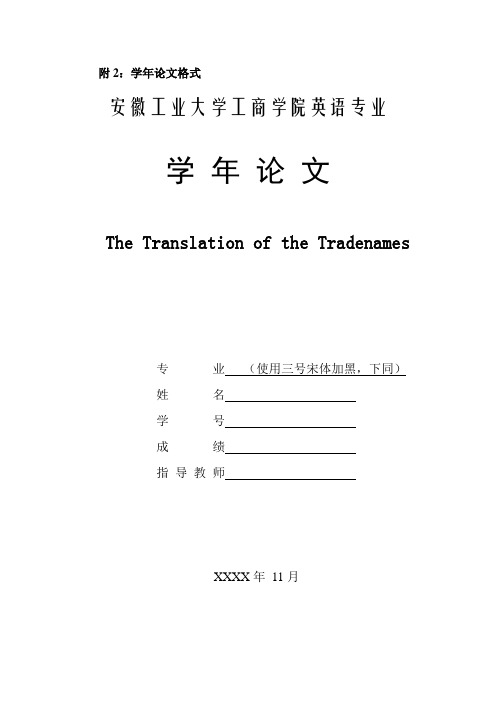
附2:学年论文格式安徽工业大学工商学院英语专业学年论文The Translation of the Tradenames专业(使用三号宋体加黑,下同)姓名学号成绩指导教师XXXX年11月ContentsAbstract (i)摘要...................................................................................... i ii 1 Introduction (1)2Trademark significance (2)2.1 Cultural properties of trademark (2)3Several Forms of Trademark Translation (3)3.1 Special translation (另类译法) (3)3.2 Free translation (直译) (3)3.3Transliteration (音译) (3)4 Conclusion (13)The Translation of the Tradenames Abstract:Trademark is closely related to the commodity. A goodtrademark can make desire to inspire people to buy . In order to achieve maximum benefits . so , trademark as a special symbol , a commodity producer or operator to make their own production is very helpful to attract consumers and let them to buy . In the cognitive framework of pragmatics relevance theory , human communication behaviour will produce the best expectation to try to deal with minimal effort to obtain adequate contextual effects, to achieve commeracial success.Key Words: Trademark; a special symbol; attract consumers摘要:英文商标是一种特殊的商业语言符号,他是商品的灵魂文化的核心部分。
英语专业学年论文

英语专业学年论文语音是口头交际的基础,也是语言教学的出发点。
下面是店铺为大家整理的英语专业学年论文,供大家参考。
英语专业学年论文范文一:情感过滤效应在外语教学中的应用摘要:本文从情感过滤效应学说出发,解释了语言教学过程,不仅是认识过程,传授知识的过程,而且是情感交流的过程。
同时,笔者认为情感过滤学说不够完善,不能解释语言教学中的各种现象,进而提出了自己的看法。
论文关键字:情感过滤效应情感交流过程情感过滤理论(Affective Filters)是在一九八三年由西方语言学家克拉申(Krashen)提出的。
他的理论可用正面图说明:Filter(过滤器)Input(语言习得机制) (学习者的能力)他认为,“在语言教学过程中,老师讲授的语言知识(即Input输入)需经过一个情感过滤器(即filter)的作用方可进入学生的语言习得机制(即languageacquisition device),其后再转换为学生的语言能力(acquirer’s competenc e)。
”[1]所谓情感过滤器是指师生关系。
他认为,“在语言教学过程中老师采取愈理想的态度,情感过滤器的阻力则愈小;若情感过滤器阻力降至最低点,过滤时教师的输入对学生的语言习得机制将呈完全开放状态,可完全通过过滤器而直达学生,使其获得最佳学习状态。
”[2]这样,学生就会激发起更高的学习欲望,主动要求更多的输入,同时也能够获得更多的输入。
克拉申(Krashen)提出的情感过滤理论把语言学理论与语言教学实践联系起来,认为语言是通过接受可理解性输入而产生的。
由此可以看出,情感过滤学说是符合教育学与心理学规律的,有它新颖性,对语言教学活动,特别是对外语教学有重要指导意义。
教学过程是教师、学生的主要实践活动。
凯洛夫的《教育学》认为,“教学过程是一种在教师指导下,学生学习前人已经认识了的知识技能,培养一定观点和道德品质的认识过程。
”[2]即教学过程是一种特殊的认识过程。
英语语言学毕业论文(精选多篇)
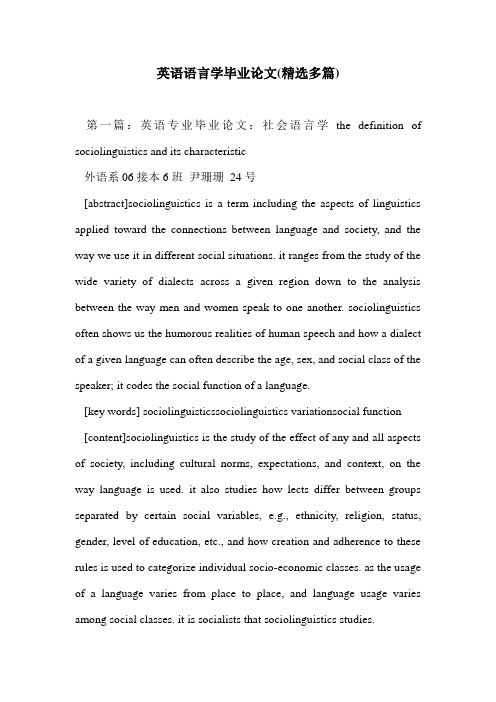
英语语言学毕业论文(精选多篇)第一篇:英语专业毕业论文:社会语言学the definition of sociolinguistics and its characteristic外语系06接本6班尹珊珊24号[abstract]sociolinguistics is a term including the aspects of linguistics applied toward the connections between language and society, and the way we use it in different social situations. it ranges from the study of the wide variety of dialects across a given region down to the analysis between the way men and women speak to one another. sociolinguistics often shows us the humorous realities of human speech and how a dialect of a given language can often describe the age, sex, and social class of the speaker; it codes the social function of a language.[key words] sociolinguisticssociolinguistics variationsocial function [content]sociolinguistics is the study of the effect of any and all aspects of society, including cultural norms, expectations, and context, on the way language is used. it also studies how lects differ between groups separated by certain social variables, e.g., ethnicity, religion, status, gender, level of education, etc., and how creation and adherence to these rules is used to categorize individual socio-economic classes. as the usage of a language varies from place to place, and language usage varies among social classes. it is socialists that sociolinguistics studies.the study of language variation is concerned with social constraints determine language in its contextual environment. code-switching is the term given to the use of different varieties of language in different social situations. sociolinguistic differs from sociology of language in that the focus of sociolinguistics is the effect of the society on the language, while the latter’s focus is on the language’s effect on the society. while the study of sociolinguistics is very broad, there are a few fundamental concepts on which most sociolinguistic inquiries depend. sociolinguistics is different from many of the other branches of linguistics in that it studies external as opposed to internal language. internal language applies to the study of language on the abstract level, or in the head, put simply. external language applies to language in social contexts, or outside the head. this distinction is important, because internal language analyses, such as syntax and semantics, operate1on the assumption that all native speakers of a language are quite homogeneous in how they process and perceive language. external language fields, such as sociolinguistics, attempt to explain why this is in fact not the case. these two approaches, while distinct, complement each other in practice.understanding language in society means that one also has to understand the social networks in which language is embedded. this may apply to the macro level of a country or a city, but also to the inter-personal level ofneighborhoods or a single family.sociolinguistics as a field distinct from dialectology was pioneered through the study of language variation in urban areas. whereas dialectology studies the geographic distribution of language variation, sociolinguistics focuses on other sources of variation, among them class. class and occupation is one of the most important linguistic markers found in society.one of the fundamental findings of sociolinguistics, which has been hard to disprove, is that class and language variety are related. as can be implied from the example below, the working class tends to speak less standard language. the lower, middle, and upper middle class will in turn speak closer to the standard. however, the upper class, even members of the upper middle class, may often speak ‘less’ standard than the middle class. this is because not only class, but class aspirations, are important. men and women, on average, tend to use slightly different language styles. these differences tend to be quantitative rather than qualitative. that is, to say that women make more minimal responses than men is akin to saying that men are taller than women. the initial identification of a women’s register was by robin lakoff in 1975, who argued that the style of language served to maintain women’s role in society. a later refinement of this argument was that gender differences in language reflected a power difference. however, both these perspective have the language style ofmen as normat ive, implying that women’s style is inferior. more recently, deborah tannen has compared gender differences in language as more similar to ‘cultural’ differences. comparing conversational goals, she argued that men have a report style,aiming to communicate factual information, whereas women have a rapport style, more concerned with building and maintaining relationships. such differences are pervasive across mediums, including face-to-face conversation, written essays of primary school children, email, and even toilet graffiti. communication styles are always a product of context, and as such, gender differences tend to be most pronounced in single-gender groups. one explanation for this, is that people accommodate their language towards the style of the person they are interacting with. thus, in a mixed-gender group, gender differences tend to be less pronounced. a similarly important observation is that this accommodation is usually towards the language style, not the gender of the person. that is, a polite and empathic male will tend to be accommodated to on the basis of their being polite and empathic, rather than their being male. sociolinguistics has drawn more and more attention since it became an independent discipline in mid 1960s. but scholars from various disciplines look at sociolinguistics from different perspectives, and carry out sociolinguistic study in different ways. this paper tries to understand sociolinguistics in terms of its definitions and the scope of sociolinguisticstudy to point o ut the lack of comprehensiveness in fishman’’s view on the definition of sociolinguistics.参考文献:《社会语言学概论》戴庆厦主编商务印书馆《社会语言学概论》祝畹瑾编著湖南教育出版社.《语言学概论》杨信彰高等教育出版社第二篇:英语语言学论文题目英语语言学论文题目13论国际商务谈判中的语言交际技巧33成人世界的童话——从文体学角度解析现今童话再度流行的现象49论文化差异与英汉商标互译55浅谈英汉句子结构差异59诗意的美和喜剧性幽默62试论广告英语的语言特点65统觉团对英语初学者词汇学习的影响67外语学习中应该重视中介语的作用69新闻报道中的转述动词研究73英汉禁忌语、委婉语的对比研究74英汉数字习语的对比研究76英译汉中词序的变动78英语广告的语言特征80英语双关语汉译的可译性限度101词义演变的原因与方式137从汉语中英语借词的翻译看文化交流138从价值观转换看斯佳丽的角色特征142从礼貌准则看中英文化的异同146从习语看英汉民族的文化差异149从英语人名中看性别歧视157动词过程类型的选择和话语隐性态度的表达161对母语在英语写作中词汇负迁移现象的思考162对严复译作中“信”的质疑167法律英语用词特征分析168法律语言翻译与法律文体177副词ever的句法环境和语义特征180功能语法视角下的英语报纸新闻标题的功能183广告口号语的语言特点189国际商务文化之对比研究204汉语中双关语的翻译213基于概念隐喻的诗歌解读228论广告英语中的幽默265论广告英语的语言特点268论汉英谚语的语言特征280论清教理念与美国西进运动282论莎士比亚十四行诗中的时间300论英语广告中几种常用修辞格及其汉译310论尤金?奥尼尔的表现主义手法324名词化的语篇功能330诺曼时期法语对英语词汇的影响339浅谈英语虚拟语气的语用功能340浅谈英语虚拟语气及其语用功能345浅析二十世纪计算机英语词汇的构成特点346浅析汉英动物谚语中的文化348浅析英汉语言中的性别歧视现象及其根源349浅析英语禁忌语及其发展352浅析英语无标志被动句356浅议译者能力359认知语言学角度下“within” 的空间隐喻意义365商标英语汉译的原则和方法384体育新闻英语文体研究375社会语言学视野中的网络语言418新闻英语中的语法特点研究423颜色词在英汉互译中的不对应性425移就的审美价值和生成基础426以认知为基础的颜色隐喻研究428隐喻认知功能研究的新视角429隐喻与一词多义的关系438英汉被动句对比研究439英汉宾语类型差异的认知原因440英汉动词非谓语用法之比较研究442英汉否定问句的答句对比研究443英汉汉英双关语及其翻译研究444英汉合成词构词对比研究446英汉名词短语修饰模式比较447英汉拟声词异同探讨448英汉人称代词运用对比研究449英汉人名的比较研究450英汉时间的空间隐喻对比研究451英汉习语的文化共性和个性的研究453英汉颜色词的引申义的文化差别454英汉颜色词跨域对比分析?—以red和红为例458英汉隐喻性词汇对比研究462英汉语中红绿色文化比较468英语道歉方式研究469英语动物词汇的文化内涵与汉译470英语复合词的语义分析及其类型471英语惯用句型的意义及汉译480英语情态助动词的主客观区别485英语委婉语的使用原则与策略487英语语言性别歧视现象研究488英语语言中的性别歧视491英语中的性别歧视508源语中的“异”与译语中的“达”522中美拒绝言语行为研究523中美礼貌用语跨文化对比分析524中美企业文化比较的启示533中西人名文化对比534中西饮食文化差异536中学生英语学习策略研究543中英非语言交际的文化差异及对比544中英恭维语对比研究545中英广告中语言使用对比研究546中英两种语言中的颜色词及其象征意义547中英亲属词的文化内涵分析548中英请求言语行为策略选择之比较552宗教对中美节假日的影响553介词in的语义向度:认知视角554近代英美关系及其文化基础559跨文化交际中非语言交际及其文化基础561快餐食品对中西方传统饮食文化的影响力570语境对词义的制约作用第三篇:06级毕业论文语言学06级毕业论文语言学:1. 浅谈非语言交际中的身势语body language on nonverbal communication2. 浅论英汉语被动句的异同a brief study on the meaning of similarities and differences betweenenglish and chinese passive3. 英式英语与美式英语的对比分析the distinctive analysis between british english and american english4. 隐喻理论在词汇教学中的应用the application of conceptual metaphor theory in vocabulary teaching5. 二语习得中的个人因素personal factors in second language acquisition6. 对比研究下的英汉新闻语篇中的语法隐喻grammatical metaphor in english and chinese news contrastive approach 7. 英语诗歌语言的修辞美the rhetorical beauty in the language of english poetry8. 英语口语交际能力形成的培养the formation of communicative competence in oral english training9. 美国黑人英语特色研究the phonological features of american black english10. 法律新词在英语中的应用the new legal words used in english11. 从词汇方面分析英语中的性别歧视语analysis on the glossaries of gender discrimination from the lexicological aspect12. 英语中的否定句on the english negative sentences13. 非言语交际中的面部表情的特征the signs of facial expression in non-verbal communication14. 词义演变的原因和方式on the causes and ways of evolution on word meaning15. 言语行为理论对语言教学的影响the influence of speech act theory on language teaching16. 从交际功能看英汉委婉语a comparative analysis of english and chinese euphemisms from the perspective of communication function17. 论文摘要的语类结构分析the analysis of generic structure in english thesis abstract18. 语言环境对二语习得的影响influence of language environment on second language acquisition19. 公共演讲的文体特征stylistic features of public speech20. 关于英语幽默的文化特点的研究a study of cultural features in english humor21. 浅谈科技文中动词名词化现象及其翻译the analysis on nominalization in est and its translation22. 语境在话语理解中的作用on the role of context in utterance interpretation23. 运用词块法记忆英语单词的实效研究on the effectiveness of chunks in the memorization of english words 24. 试论动词-ing形式在中学教学中的应用the study of v-ing form and its application to teaching in middle school 25. 英语写作目的与写作风格之间的联系the relation between english writing purpose and its style26. 青年流行语及其社会文化心理探微research on vogue words and the related social cultural psychology of the young27. 关于肢体语言的研究study on body language28. 从美国总统奥巴马就职演说辞看其演说的文体风格stylistic analysis of the inauguration speech of american president barack obama29. 论广告英语中的句法特征on syntactic characteristics of english for advertising30. 母语习得与二语习得的对比the comparison between native language acquisition and the second language learning31. 浅析英语句子的歧义性an analysis on ambiguity in english sentences32. 语用失误及其策略研究33. 会话含义初探analysis of conversational implicatures34. 交际中性别差异的研究study of gender differences in verbal communication35. 浅析母语对二语习得的影响on the influence of mother tongue on the second language acquisition 36. 论语境在话语理解中的作用the function of context in language interpretation37. 浅谈模糊语的语用功能及其应analysis of pragmatic functions of vague language and its application 38. 英语歧义现象初探the analysis of ambiguity in english39. 论英语中的性别歧视现象on sexism in english40. 动物词的中英文化内涵对比different connotation of animal words between english and chinese culture41. 沉默在英语会话中的运用及影响因素the use of silence in conversation and its implication42. 英语新闻的批判性分析a critical analysis of english news reports43. 英语词汇中的外来语词汇的演变the developments of english loan words44. 英语新闻标题的特点分析the characteristics of english newspaper45. 关于英语习语文化内涵的探讨a study of english idioms from the perspective of culture46. 浅析英语中的歧义现象a brief discussion on ambiguity in english47. 语境对词义的影响the effect of context on the meaning of the words48. 交际中的说谎探究a study of lying in the communication49. 形态学探究及在翻译中的应用exploration on morphology and its using in translation50. 浅析英语双关语在广告中的语用功能analysis on the pragmatic function of english puns in advertisement51. 试论反语的幽默属性和语用功能on the humor features and pragmatic function of verbal irony52. 浅谈外交语言a study on diplomatic language53. 母语和第二语言阅读的认知体系差异differences in cognitive system between mother tongue reading and the second language reading54. 论法国文化对英语词汇的影响the french influence on english vocabulary55. 浅析英语中存在的性别歧视现象a brief analysis of the sexism in english56. 政治委婉语及其修辞应用political euphemism and its application of rhetoric 57. 原版电影与英语学习original film and english learning58. 浅析系统功能语言学对语言学习的影响59. 东北方言对英汉语音习得产生的影响60. 现代英语词汇衍变动因探究61. 浅谈英语语调62. 关于美国俚语功能的研究63. 提高外语学习中词汇习得能力的研究64. 现代仿拟创新研究65. 文化因素对语言交际的影响66. 认知视角下的英语隐喻分类研究67. 英语委婉语的交际功能68. 肯尼迪总统就职演讲的文体分析69. 浅谈英语歧义现象70. 对情景喜剧《老友记》的文体学分析71. 流行语对社会的影响72. 认知语境对话与的解释和制约73. 英语中的汉语借词74. 语篇中的衔接75. 从社会语言学的角度分析网络语言76. 英语中语言的性别差异小议gender differences in the use of english77. 语言的社会变体及其社会意义78. 英语模糊限制语的人际功能探究79. 英语习语的修辞分析80. 英语中外来语的形成及运用81. 浅析英语演变的整体性及其演变原因82. 解析礼貌原则及其文化特征83. 浅析言语行为理论84. 浅析英语中主要介词的功能85. 论广告英语的语言特点86. 论合作原则在翻译中的应用87. 基于合作原则的英语言语幽默分析第四篇:语言学毕业论文参考题目语言学毕业论文参考题目一、现代汉语1.略论“了1”与“了2”的语法功能差异2.“还”、“又”、“也”的功能比较3.汉语副词“一直”、“一向”比较研究4.“从来”、“历来”、“向来”比较研究5.程度副词“十分”、“非常”句法语用研究6.简析“差点儿”和“差点没”的关系7.说“一点儿”与“有点儿”8.“名+名”语法小类试析9.试论汉语概数表示法的多样性10.现代汉语语气副词的功能分析11.汉语词类研究述评12.“相当”语法化过程及个人在语言约定论中作用辨析13.谈谈状语的非常规位置及其作用14.语法知识在作文批改中的运用(体会)15.语文教学中的语言分析(提示:中学语文教学存在重文学轻语言的倾向,语言分析往往孤立进行,如何综合内容及篇章进行语言分析,分析要领及原则是什么?试以具体的课文分析为例,展开具体论述。
大学英语专业论文六篇
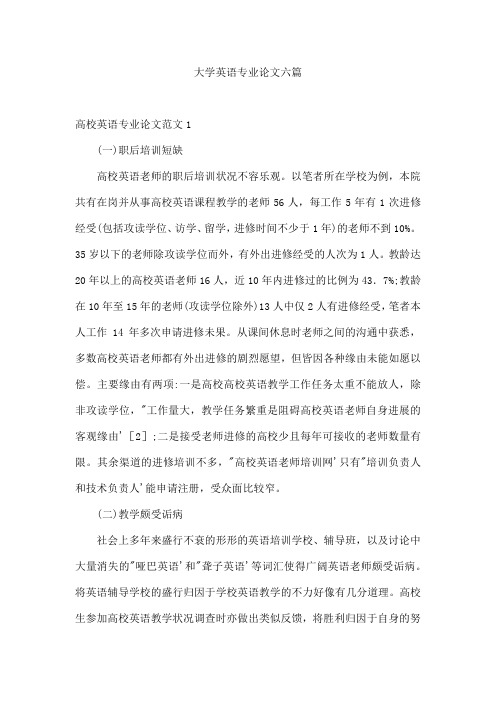
大学英语专业论文六篇高校英语专业论文范文1(一)职后培训短缺高校英语老师的职后培训状况不容乐观。
以笔者所在学校为例,本院共有在岗并从事高校英语课程教学的老师56人,每工作5年有1次进修经受(包括攻读学位、访学、留学,进修时间不少于1年)的老师不到10%。
35岁以下的老师除攻读学位而外,有外出进修经受的人次为1人。
教龄达20年以上的高校英语老师16人,近10年内进修过的比例为43.7%;教龄在10年至15年的老师(攻读学位除外)13人中仅2人有进修经受,笔者本人工作14年多次申请进修未果。
从课间休息时老师之间的沟通中获悉,多数高校英语老师都有外出进修的剧烈愿望,但皆因各种缘由未能如愿以偿。
主要缘由有两项:一是高校高校英语教学工作任务太重不能放人,除非攻读学位,"工作量大,教学任务繁重是阻碍高校英语老师自身进展的客观缘由'[2];二是接受老师进修的高校少且每年可接收的老师数量有限。
其余渠道的进修培训不多,"高校英语老师培训网'只有"培训负责人和技术负责人'能申请注册,受众面比较窄。
(二)教学颇受诟病社会上多年来盛行不衰的形形的英语培训学校、辅导班,以及讨论中大量消失的"哑巴英语'和"聋子英语'等词汇使得广阔英语老师颇受诟病。
将英语辅导学校的盛行归因于学校英语教学的不力好像有几分道理。
高校生参加高校英语教学状况调查时亦做出类似反馈,将胜利归因于自身的努力,而将失败归因于高校英语老师的教学不得法[3]。
此处暂不考虑这样的归因是否合乎规律,但高校英语老师无论如何是脱不了干系的。
首先,绝大多数中学校英语老师是高等教育培育的。
其次,作为"哑巴英语'和"聋子英语'携带者的高校生们刚走出高校校门即被识破,充分说明高校英语的教学质量如何。
再者,为提高高校英语教学质量,21世纪以来,高校英语教学改革的不断推动和是否广泛推广ESP专业英语教学的争辩热点都不约而同地指向高校英语老师专业化进展的必要性和紧迫性。
英语专业毕业论文范文(1)

英语专业毕业论文范文A Brief Analysis of english teaching in senior high schoolAbstract: Classroom teaching is the main way for students to learn En glish. But in senior high school, a lots of probelms still exsit in t he English teaching especially in the teaching of reading and writing. In this paper, the importance and methods of reading and writing w ill be further discussed. Key words: reading writing techniqu esIntroduction: Classes should be learner-centered, with meaningful, fu nctional activities, often, classes begin by finding out what the stu dents don’t know. These classes operate on the assumption that there is a great deal of information that students lack and that the teache r and textbooks will impact that information to the students. Teacher s who hold this assumption view students as plants waiting passively to be fed and watered. But I think the students should be regarded as explorers, active learners who bring a great deal to the learning pr ocess and at the same time, draw from their environment as they devel op new understandings. The basic principle will be used in the teachi ng of reading and writing.Section One------ How to teach readingI. Why teach readingThere are many reasons why getting students to read English texts is an im portant part of the teacher’s job. In the first place, many of them want to be able to read texts in English either for their career s, for study purposes or simply for pleasure. Anything we can do to m ake reading easier for them must be a good idea.Reading texts provide good models for English writing, provide opp ortunities to study language vocabulary, grammar, punctuation, and th e way to construct sentences, paragraphs and texts. Lastly, good read ing texts can introduce interesting topics, stimulate discussion, exc ite imaginative responses and be the springboard for well-rounded, fa scinating lessons.The last but not the least, students must read widely because only a fraction of knowledge about the world can come from other experien ces in their short lives.II. What kind of reading should students do?When the teachers give reading class to students, they should noti ce a balance----a balance to be struck between real English on the on e hand and the students’ capabilities and interests on the other. There is some authentic written material which beginner students can un derstand to some degree: menus, timetables, signs and basic instructi ons, for example, and, where appropriate, teachers can use these. But for longer prose, teachers can offer their students texts, which, wh ile being like English, are nevertheless written or adapted especiall y for their level. Anyway, the materials to be read should be interes ting and meaningful. Teachers should become better acquainted with bo oks written specially for teenagers and dealing with their problems. III. What are the principles behind the teaching of reading?i) Permit Students To ReadNo one has learned to swim by practicing the skills of backstrokes, f lutter kicks or treading water while staying on the edge of the swimm ing pool. Yet, in the teaching of reading teachers often do just that. Rather than let the students into “the water”, teachers keep them in skills books learning rules about letters, syllables or definition s of words rather than letting them into the book itself, permitting them to be immersed in the language which comes from the authors as the readers try to reconstruct the written message.ii) Encourage students to respond to the content of a reading text, n ot just to the languageOf course, it is important to study reading texts for the way they us e language, how many paragraphs they contain and how many times they use relative clauses. But the meaning, the message of the text, is mu ch more important. Teachers should help students understand that the main reason to read is for them. They have to have their own purpose to read and reading must make sense, they have to find ways of doing something about it. They should be encouraged either to reread or to continue reading to gain meaning. But they must realize that the mean ing is not in the teacher, but in the interaction between the reader and author. Students should be encouraged to ask themselves repeatedl y, “Does this make sense to me?” Students should be encouraged to r eject and to be intolerant of reading materials that do not make sens e.iii) Encourage students to guess or predictReaders’ guesses or predictions are based on the cumulative infor mation and syntactic structure they have been learning as they have b een reading. Therefore, their guesses are more often than not appropr iate to the materials. Students have to realize that risk taking in r eading is appropriate; that using context to decide what words mean i s a proficient reading strategy and that they have the language sense to make appropriate guesses which can fit both the grammatical and s emantic sense of what they are reading.iv) Match the task to the topicOnce a decision has been taken about what kind of reading text the students are going to read, teachers need to choose good reading tas ks—the right kind of questions and useful puzzles, etc. Asking borin g and inappropriate questions can undermine the most interesting text; the most commonplace passage can be made really exciting with imagin ative and challenging tasks. Working in groups, the English teacher a nd students take turns asking each other questions following the read ing. The teacher may ask, “ What is the significance of the characte r’s age?” These questions require inferences based on details from the reading text.Section Two------How to teach writing (Developing correctness in stud ents’ writing)“Students learn to write by writing, and they learn to write co rrectly by writing, revising, and proofreading their own work”---wit h some help or direction from the teacher when it is necessary. They do not learn to write correctly by studying about writing or doing is olated workbook exercises unrelated to their own writing. So, the mos t important technique a teacher can use to guide students toward gram matically correct writing is to let them write, let them write things related to their own experiences. There is no limit to the kinds of text the teacher can ask students to write. Teachers’ decisions, tho ugh, should based on how much language the students know, what their interests are.“Do I read a paper and ignore all punctuation, what good is that for studentsWe spend hours at night with papers---I’m not sure the students get as much from it as the time I spend on it.”These comments by senior high school English teachers discussing the process of marking student papers reflect the dissatisfaction an d frustration of many teachers over the problem of dealing with the e rrors in student writing-----the obvious mistakes in spelling, punctu ation----Traditionally, teachers have worked to correct errors in two ways: by teaching grammatically correctness through exercise in gram mar texts; by pointing out all errors when making student papers.Most students find it very dispiriting if they get a piece of wr itten work back and it is covered in red ink, underlings and crossing -out. It is a powerful visual statement of the fact that their writte n English is terrible. Of course, some pieces of written work are com pletely full of mistakes, but even in these cases, the teacher has toachieve a balance between being accurate and truthful on the one han d and treating students sensitively and sympathetically on the other.Some techniques can be used in dealing with the errors in studen t papers:i) SelectivityRather than engage in intensive error-correction when responding to s tudent writing, teachers are encouraged to adopt a more moderate appr oach to error. If the teacher over-corrects the students’ mistakes, the students would be likely to focus on errors instead of ideas. Stu dents are more likely to grow as writers when the teacher’s primary purpose in reading student papers is to respond to content. However, if attention to content and correctness are combined when making pape rs, it is more helpful to select one or two kinds of errors the indiv idual student is making than to point out every error in the paper. T he teacher can identify a selected error, show an example or two on t he student paper, and either explain the correct form or direct the s tudent to a handbook for further explanation. It is always worth writ ing a comment at the end of a piece of written work -----anything fro m “Well done” to “This is a good story, but you must look again at your use of past tenses---see X grammar book page xx.”ii) Error-analysisAnother method for working with student error, one that can be especi ally fruitful for teachers, is to approach it from an analytic perspe ctive. Teachers, as error-analyst, look for patterns in the errors of an individual student, tries to discover how the mistake arrived at the mistakes by analyzing the error (Lack of knowledge about a certai n grammatical point; A careless one or a mis-learned rule?), and plan s strategies accordingly.iii) Publish Student WritingThe final basic strategy is publishing. Students need a reason for la boring over a draft until it is perfect; the urge to see oneself in p rint can be a powerful drive toward revision and proofreading.Conclusion: As teachers to the students who are in senior high sch ool, t hey should learn to turn students’ hard work toward supporting the language strengths students already have, proving students with a feeling of success, finding materials and planning classroom experie nces will turn students on to reading and writing, the reading and wr iting will develop with much greater ease than it does at the present time.Reference:Gu Xueliang, The Basic Technical Training in English Teaching, Hangzhou University Press, 1998.Wilga M.Rivers & Mary S. Temperley, A practical guide to the teaching of English as a second or foreign Language, New York: Oxford Univers ity Press, 1978Smith F. Understanding Reading (2d ed), New York: Holt, Rinehart an d Winston, 1978毕业答辩注意事项及技巧1、自己为什么选择这个课题?2、研究这个课题的意义和目的是什么?3、全文的基框架、基结构是如何安排的?4、全文的各部分之间逻辑关系如何?5、在研究课题的过程中,发现了那些不同见解?对这些不同的意见,自己是怎样逐步认识的?又是如何处理的?6、论文虽未论及,但与其较密切相关的问题还有哪些?7、还有哪些问题自己还没有搞清,在论文中论述得不够透彻?8、写作论文时立论的主要依据是什么?对以上问题应仔细想一想,必要时要用笔记整理出来,写成发言提纲,在答辩时用。
英语专业论文(5篇)
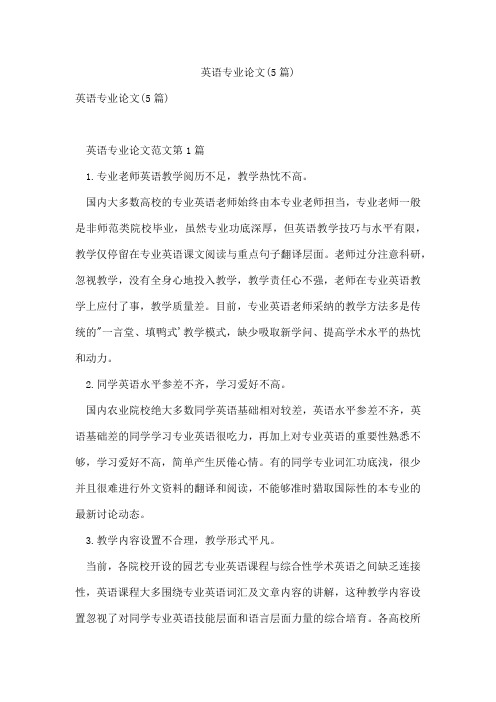
英语专业论文(5篇)英语专业论文(5篇)英语专业论文范文第1篇1.专业老师英语教学阅历不足,教学热忱不高。
国内大多数高校的专业英语老师始终由本专业老师担当,专业老师一般是非师范类院校毕业,虽然专业功底深厚,但英语教学技巧与水平有限,教学仅停留在专业英语课文阅读与重点句子翻译层面。
老师过分注意科研,忽视教学,没有全身心地投入教学,教学责任心不强,老师在专业英语教学上应付了事,教学质量差。
目前,专业英语老师采纳的教学方法多是传统的"一言堂、填鸭式'教学模式,缺少吸取新学问、提高学术水平的热忱和动力。
2.同学英语水平参差不齐,学习爱好不高。
国内农业院校绝大多数同学英语基础相对较差,英语水平参差不齐,英语基础差的同学学习专业英语很吃力,再加上对专业英语的重要性熟悉不够,学习爱好不高,简单产生厌倦心情。
有的同学专业词汇功底浅,很少并且很难进行外文资料的翻译和阅读,不能够准时猎取国际性的本专业的最新讨论动态。
3.教学内容设置不合理,教学形式平凡。
当前,各院校开设的园艺专业英语课程与综合性学术英语之间缺乏连接性,英语课程大多围绕专业英语词汇及文章内容的讲解,这种教学内容设置忽视了对同学专业英语技能层面和语言层面力量的综合培育。
各高校所用的教材主要有自选原版英文教材和自行选编教材两种形式,自编教材内容编排过于古板、陈旧,还有的教材内容难度偏高或者涉及的专业内容过于简洁,不能满意专业要求。
再有,各高校通常采纳传统的"填鸭式'教学模式,偏重于老师的讲解,教学内容枯燥,教学形式单一,忽视了同学的主动性和制造性,同学学习的乐观性不高,同学只是被动接受学问。
这种教学形式比较死板,同学无法参加到教学过程中,扼杀了同学的学习爱好与英语语感的培育,最终导致我国专业英语缺乏创新性的局面。
二、本项园艺专业英语教学改革特色与成效在园艺专业英语教学实践中尝试了一系列园艺专业英语教学改革并取得了肯定成效,详细改革如下。
英文论文(优秀4篇)
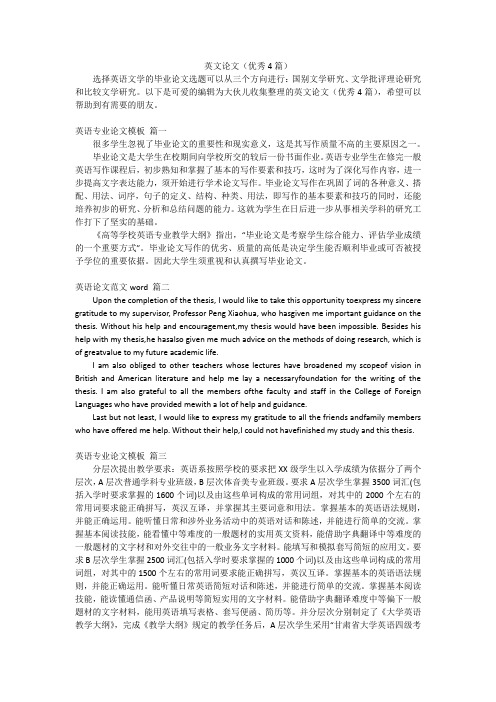
英文论文(优秀4篇)选择英语文学的毕业论文选题可以从三个方向进行:国别文学研究、文学批评理论研究和比较文学研究。
以下是可爱的编辑为大伙儿收集整理的英文论文(优秀4篇),希望可以帮助到有需要的朋友。
英语专业论文模板篇一很多学生忽视了毕业论文的重要性和现实意义,这是其写作质量不高的主要原因之一。
毕业论文是大学生在校期间向学校所交的较后一份书面作业。
英语专业学生在修完一般英语写作课程后,初步熟知和掌握了基本的写作要素和技巧,这时为了深化写作内容,进一步提高文字表达能力,须开始进行学术论文写作。
毕业论文写作在巩固了词的各种意义、搭配、用法、词序,句子的定义、结构、种类、用法,即写作的基本要素和技巧的同时,还能培养初步的研究、分析和总结问题的能力。
这就为学生在日后进一步从事相关学科的研究工作打下了坚实的基础。
《高等学校英语专业教学大纲》指出,“毕业论文是考察学生综合能力、评估学业成绩的一个重要方式”。
毕业论文写作的优劣、质量的高低是决定学生能否顺利毕业或可否被授予学位的重要依据。
因此大学生须重视和认真撰写毕业论文。
英语论文范文word 篇二Upon the completion of the thesis, I would like to take this opportunity toexpress my sincere gratitude to my supervisor, Professor Peng Xiaohua, who hasgiven me important guidance on the thesis. Without his help and encouragement,my thesis would have been impossible. Besides his help with my thesis,he hasalso given me much advice on the methods of doing research, which is of greatvalue to my future academic life.I am also obliged to other teachers whose lectures have broadened my scopeof vision in British and American literature and help me lay a necessaryfoundation for the writing of the thesis. I am also grateful to all the members ofthe faculty and staff in the College of Foreign Languages who have provided mewith a lot of help and guidance.Last but not least, I would like to express my gratitude to all the friends andfamily members who have offered me help. Without their help,I could not havefinished my study and this thesis.英语专业论文模板篇三分层次提出教学要求:英语系按照学校的要求把XX级学生以入学成绩为依据分了两个层次,A层次普通学科专业班级,B层次体音美专业班级。
- 1、下载文档前请自行甄别文档内容的完整性,平台不提供额外的编辑、内容补充、找答案等附加服务。
- 2、"仅部分预览"的文档,不可在线预览部分如存在完整性等问题,可反馈申请退款(可完整预览的文档不适用该条件!)。
- 3、如文档侵犯您的权益,请联系客服反馈,我们会尽快为您处理(人工客服工作时间:9:00-18:30)。
英语专业学年论文English Rhetoric专业;姓名:学号:成绩:指导教师:2010年11月ContentsAbstract (3)摘要 (3)1 Introduction (3)2 Communicative Rhetor ic (3)3Aesthetic Rhetoric (4)4 Syntactical Stylistic Devices (5)5 Phonetic Stylistic Devices (6)6 Conclusion (8)7Bibliography (8)8学年论文成绩评定 (9)English RhetoricAbstract: language is the most important tool for communication. In our daily life, we not only have to express our ideas clearly, but also exactly、concisely and profoundly. We can achieve the best perlocution only by this way. In order to do that, people try their best to use the language with proper language devices and adjust our language continuously, in the end we named this action: rhetoric. There is no boundary in rhetoric’s world just like music. But with different features and custom of language, we should learn to understand these differences and distinguish them from each other.Key words: language tool 、language devices、rhetoric摘要:语言是人类最重要的交际工具。
人类在社会交往中,不仅要使语言清晰、流畅、合乎逻辑和语法,而且还要在这个基础上,进一步做到语言鲜明、准确、精炼、生动、深刻,具有感人的力量,以期达到最佳的表达效果。
为此,人们充分地运用和发挥语言各因素的作用,恰当地选择语言手段,不断地对语言进行调整、加工、润色,于是就产生了修辞。
就如同音乐一样,修辞也是无国界的。
但由于不同国家和地区的语言使用习惯和特点不同,我们学习这些差异,最终能够区分出来。
关键词:语言工具、表达手法、修辞IntroductionWhat is rhetoric and where does it come from? According to rhetorician and linguist, rhetoric is the theory of information and persuasive. It is the art of using words in speaking or writing so as to persuade or influence others. Rhetoric concerns on how to make an effective choice between two synonymous expressions. Rhetoric comes from our daily use and develops with our language. Rhetoric is a subject of language. The object of study should be language elements. It does not study the features of language in detail. To achieve the best perlocution , we should have a correct attitude towards rhetoric. Only with enough realization of the importance, can we have the motive to learn rhetoric. With the ability to use rhetoric , we can improve our expressive skills and make our article more exactly、concisely and profoundly.Communicative RhetoricIn order to express our ideas clearly and concisely, we need to learn how to select the proper words and phrases, which is called diction. Diction is very important inrhetoric and it is the foundation of rhetoric. Before we start to select words, we should have abundant vocabulary, then we have to know when and where to use the correct words. It means we can choose the best word according to the situations, becausemany word have the similar meaning. For example:The great night duly arrived, moonlit and cloudless. A platform had been constructed in a comfortable and conveniently placed tree…Here the author choose‘great’ to describe the ‘night’, instead of ‘important’、‘significant’、‘vital’… this is because ‘great’ can give readers a feeling of surprising and different. With this function, it can leave a deep impression on our mind.Then it come s to the classification of word’s meaning. According the famous Britain linguist Geoffrey leech, it can e divided into seven kinds:Conceptual meaning、connotative meaning、stylistic meaning、affective meaning、reflected meaning、collocative meaning and thematic meaning. On the other hand, according to our traditional classification, it can be divided into three parts: commendatory terms、derogatory term and neutral terms. With these classifications, we can have better understanding on words. Just as Maupassant said ‘no matter what we are going to describe; if we want to show what it is, we should find the only noun; if we want to show its movement, we should find the only verbal; if we want to know its essence, we should find the only adjective; we must word hard to find these only words, we can not use the simila r words to replace them, this our attitude’.Aesthetic RhetoricThis part includes three elements: lexical stylistic devices、syntactical stylistic devices and phonetic stylistic devices.1. lexical stylistic devicesIn this part, we have simile, metaphor, analogy, personification, metonymy, synaesthesia, hyperbole, oxymoron, irony, pun, euphemism and parody.Simile is the most ordinary and frequently used rhetoric device. It means ‘like’, it was defined as a fingure of speech in which one thing is likened to another, in such a way as to clarify and enhance an image. It is an explicit comparison recognizable by the use of the wor d ‘like’ or ‘as’. Simile has three elements: subject(tenor),reference (vehicle)and indicator of resemblance (simile marker)。
